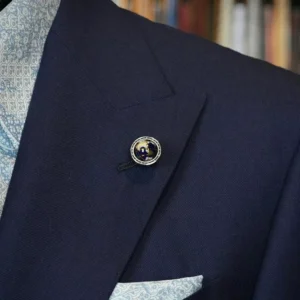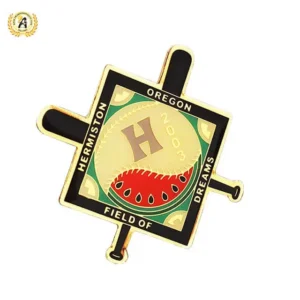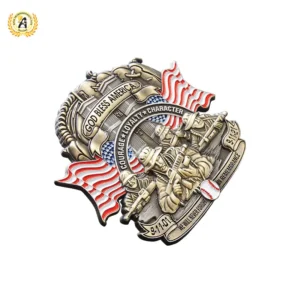Types of lapel pins
Soft Enamel Pins:
The pin’s base undergoes a plating process with gold, silver, gunmetal, or black. The concave enamel sections are color-filled and then polished, which delivers an intricately textured finish.
Hard Enamel Pins:
These lapel pins are metal-based with enamel that lies flush with the metal surface, giving a polished and premium-quality appearance.
Die-Struck Pins

Die-struck pins are crafted when a die is pressed onto a metal base, providing a raised design without color fill. So, rather than color filling, they are plated with one or more metal options to give a lustrous surface that enhances the overall design.
Offset Printed Pins

Offset printed lapel pins transfer your design onto the pin’s surface, thereby incorporating one or multiple color gradients or fade effects. These pins replicate any design you provide and serve as an example of your creative vision.
Laser-Etched Pins
Laser etching engraves intricate and precise designs onto the pin’s metal surface, offering fine and enduring details. These pins utilize thinner metal plates.
Placement of lapel pins
There are three familiar places to wear your lapel pins.
1. Your blazer’s buttonhole

To wear a lapel pin traditionally:
- Fix it to your left lapel.
- For the blazer, insert the pin through or over the lapel buttonhole.
- Ensure the pin is situated north of any pocket square. If your suit blazer lacks a dedicated lapel pinhole, securely attach it to the fabric.
2. In the middle of your tie

When not wearing a blazer, lapel pins can still be stylish. You can place one at the center of your tie. Lapel pins complement solid-colored ties well. However, if you are wearing a blazer, it’s advisable to keep the lapel pin attached to it for important meetings.
3. With a stylish dress shirt

When wearing a dress shirt, place the lapel pin on the left side, near the heart. Wearing a lapel pin can give others the impression that you are a booming business elite.
When to wear a lapel pin?
Now that you know how lapel pins make your outfit look more classy and make you look better, we now proceed to when to wear and when not to. Wearing it on the right occasion will make a lasting impression on the people around you.
Formal events
Formal events are ideal for displaying lapel pins. The lapels are typically picked when attending legal or black tie affairs in a tuxedo and represent the utmost formality and style.
Business
Lapel pins symbolize accomplishment or affiliation for employees in some enterprises. Although this tradition is less prevalent now, this practice remains in some enterprises of rich history.
Everyday wear
Not every lapel pin is appropriate for everyday routine. For example, it will be inappropriate to wear rose pins at offices. That’s where long-stemmed lapel pins enhance your daily office attire. Badges and mini pins can also be worn over casual jackets, sweaters, or duffle coats, adding characteristics and personality to your outfit.
When not to wear lapel pins?
While lapel pins are a versatile accessory worn in various settings, wearing them in certain situations and environments will be somewhat inappropriate.
Formal Funerals – It is generally inappropriate to wear decorative lapel pins at standard funerals or memorial services. Dressing in somber and respectful attire is more appropriate in such settings.
Job Interviews – While a subtle lapel pin can be a stylish accessory, it’s advisable to keep it minimal and not eye-catching when attending a job interview. The focus should be on your qualifications and skills rather than your accessories.
High-Stakes Professional Meetings – In high-stakes business or professional meetings, maintaining a conservative appearance is often recommended. Excessive or flashy lapel pins can sometimes be distracting and not severe enough for the occasion.
Court Appearances – When appearing in court, it’s best to dress conservatively and avoid distracting or attention-grabbing lapel pins. The focus should be on the legal proceedings.
Selecting the lapel pin with the proper fixing arrangements
There is a wide range of lapel pins available, each characterized by their distinct way of fastening. The following are some of the most prevalent mechanisms to fasten lapel pins.
Butterfly clutch

Printed Pin

The most traditional fastening method for most lapel pins is the butterfly clutch. It involves inserting a nail-like prong into the material and securing it with a circular clutch.
Rubber PVC Clutch

These backings are fit for vibrant and playful pins, as they are available in a wide range of colors and complement matching appearance with the pin’s design. They are similar to butterfly clutches but crafted from durable rubber and also come with plastic alternatives.
How to wear a lapel pin?

There are five steps to wear a lapel pin:
Step 1 – Wear your lapel pin on the upper left side of your suit, just above the pocket. When wearing a shirt with a pocket and a handkerchief, ensure the lapel pin does not hide behind it and is above the top of your pocket and handkerchief. Lapel pins are traditionally positioned on the left side, highlighting their placement over the wearer’s heart.
Step 2 – Gently insert the pin’s needle through the buttonhole on your lapel and ensure that the pin’s face emerges from the hole, facing forward. The needle should be positioned on the back. Avoid striking yourself with the pin needle while removing the pin’s backing.
Step 3 – When no buttonhole is on your suit, insert the lapel pin through the fabric at a slight angle, aligning it with the lapel’s orientation.
Step 4 – For stickpins, locate the area on the back of the lapel where the fabric on the front will lie flat between both ends of the pin. Align the pin to match the lapel’s subtle angle, and insert the needle through that precise location, bringing it to the front of the fabric. Secure the bottom of the stickpin, ensuring it is visible on the front side of your lapel.
Step 5 – To secure your pin, insert the backing by either screwing or clipping it onto the needle. The backing should remain concealed behind the front of your lapel, with the pin’s head extending through the buttonhole.
Care and maintenance of lapel pin
Following are some tips to care for and maintain the shine and appearance of your lapel pin it deserves:
- Don’t place lapel pins near reactive chemicals to avoid damage to the finish.
- Use warm water, mild soap, and a soft cloth to clean your lapel pin.
- Prevent prolonged exposure to light and heat to avoid fading and color changes.
- Clean your lapel pin at the end of the day to prevent diminishing its beauty and sparkle.

